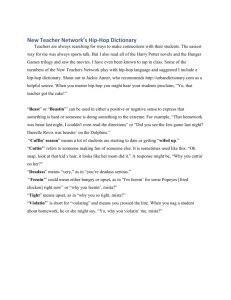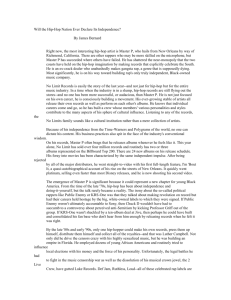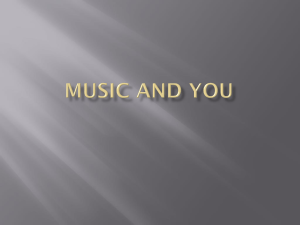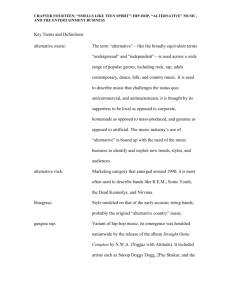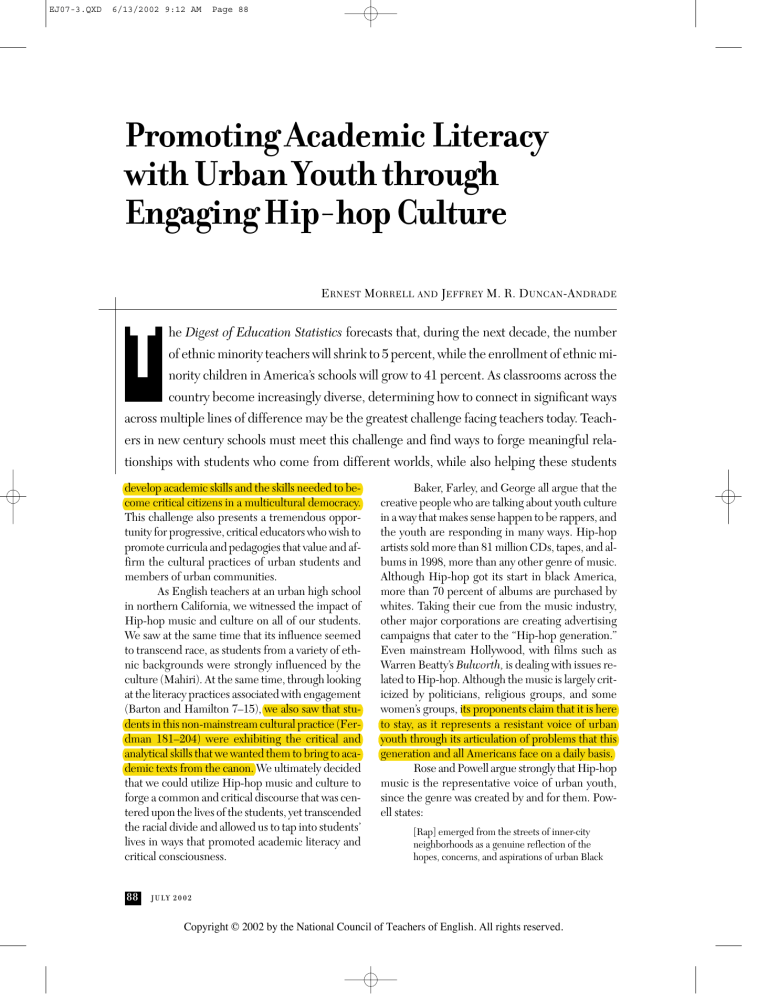
EJ07-3.QXD
6/13/2002 9:12 AM
Page 88
Promoting Academic Literacy
with Urban Youth through
Engaging Hip-hop Culture
ERNEST MORRELL AND JEFFREY M. R. DUNCAN-ANDRADE
T
he Digest of Education Statistics forecasts that, during the next decade, the number
of ethnic minority teachers will shrink to 5 percent, while the enrollment of ethnic minority children in America’s schools will grow to 41 percent. As classrooms across the
country become increasingly diverse, determining how to connect in significant ways
across multiple lines of difference may be the greatest challenge facing teachers today. Teachers in new century schools must meet this challenge and find ways to forge meaningful relationships with students who come from different worlds, while also helping these students
develop academic skills and the skills needed to become critical citizens in a multicultural democracy.
This challenge also presents a tremendous opportunity for progressive, critical educators who wish to
promote curricula and pedagogies that value and affirm the cultural practices of urban students and
members of urban communities.
As English teachers at an urban high school
in northern California, we witnessed the impact of
Hip-hop music and culture on all of our students.
We saw at the same time that its influence seemed
to transcend race, as students from a variety of ethnic backgrounds were strongly influenced by the
culture (Mahiri). At the same time, through looking
at the literacy practices associated with engagement
(Barton and Hamilton 7–15), we also saw that students in this non-mainstream cultural practice (Ferdman 181–204) were exhibiting the critical and
analytical skills that we wanted them to bring to academic texts from the canon. We ultimately decided
that we could utilize Hip-hop music and culture to
forge a common and critical discourse that was centered upon the lives of the students, yet transcended
the racial divide and allowed us to tap into students’
lives in ways that promoted academic literacy and
critical consciousness.
88
Baker, Farley, and George all argue that the
creative people who are talking about youth culture
in a way that makes sense happen to be rappers, and
the youth are responding in many ways. Hip-hop
artists sold more than 81 million CDs, tapes, and albums in 1998, more than any other genre of music.
Although Hip-hop got its start in black America,
more than 70 percent of albums are purchased by
whites. Taking their cue from the music industry,
other major corporations are creating advertising
campaigns that cater to the “Hip-hop generation.”
Even mainstream Hollywood, with films such as
Warren Beatty’s Bulworth, is dealing with issues related to Hip-hop. Although the music is largely criticized by politicians, religious groups, and some
women’s groups, its proponents claim that it is here
to stay, as it represents a resistant voice of urban
youth through its articulation of problems that this
generation and all Americans face on a daily basis.
Rose and Powell argue strongly that Hip-hop
music is the representative voice of urban youth,
since the genre was created by and for them. Powell states:
[Rap] emerged from the streets of inner-city
neighborhoods as a genuine reflection of the
hopes, concerns, and aspirations of urban Black
J U LY 2 0 0 2
Copyright © 2002 by the National Council of Teachers of English. All rights reserved.
EJ07-3.QXD
6/13/2002 9:12 AM
Page 89
youth in this, the last quarter of the 20th century.
Rap is essentially a homemade, street-level musical genre . . . Rap lyrics concentrate primarily on
the contemporary African American experience
. . . Every issue within the Black community is subject to exposition in the rap arena. Hit rap tunes
have broached touchy subjects such as sex, sexism,
racism, and crime . . . Rap artists, they contend,
“don’t talk that love stuff, but [rather] educate the
listeners.” (245)
Many rappers consider themselves as educators and
see at least a portion of their mission as promoting
consciousness within their communities (Lipsitz
23–48, Rose 277–91). As articulated by Freire, the
raising of critical consciousness in people who have
been oppressed is a first step in helping them to obtain critical literacy and, ultimately, liberation from
oppressive ideologies. The influence of rap as a voice
of resistance and liberation for urban youth proliferates through such artists as Lauryn Hill, Pras,
Wyclef Jean of the Refugee Camp, Public Enemy,
Nas, and Mos Def, who endeavor to bring an accurate yet critical depiction of the urban situation to a
Hip-hop generation.
Giroux (27–28, 31) takes a much less celebratory view of the impact of Hip-hop culture on
working-class urban youth but, nevertheless, agrees
that it is a worthy topic of study in urban schools.
His work addresses the crisis confronting youth,
whom he labels a generation under siege, where
they are enmeshed in a culture of violence coded by
race and class. He speaks to the negative connotations of youth culture promoted in popular media
that propel youth toward mistrust, alienation, misogyny, violence, apathy, and the development of fugitive cultures. This same media, he contends, has
commercialized the working class body and criminalized black youth. Critical educators, he argues,
must consider elements of popular culture such as
Hip-hop music as a serious site for social knowledge
to be discussed, interrogated, and critiqued.
Whether the power in its messages can be used for
good or ill, few can dispute the impact of Hip-hop
culture on the lives of working class urban youth.
We further argue that Hip-hop texts are literary texts and can be used to scaffold literary terms
and concepts and ultimately foster literary interpretations. Hip-hop texts are rich in imagery and
metaphor and can be used to teach irony, tone, diction, and point of view. Also, Hip-hop texts can be
analyzed for theme, motif, plot, and character de-
velopment. It is possible to perform feminist, Marxist, structuralist, psychoanalytic, or postmodernist
critiques of particular Hip-hop texts, the genre as a
whole, or subgenres such as “gangsta” rap. As Lee
points out, once learned, these analytic and interpretative tools developed through engagement with
popular cultural texts can be applied to canonical
texts as well. If one goal of critical educators is to
empower urban students to analyze complex literary
texts, Hip-hop can be used as a bridge linking the
seemingly vast span between the streets and the
world of academics. Hip-hop texts, given their thematic nature, can be equally valuable as springboards for critical discussions about contemporary
issues facing urban youth. Provocative rap texts can
be brought into the classroom, and discussion topics may be produced from a listening/reading of the
text. These discussions may lead to more thoughtful
analyses, which could translate into expository writing, the production of poetic texts, or a commitment
to social action for community empowerment.
Whether the power in its messages
can be used for good or ill,
few can dispute the impact
of Hip-hop culture on the lives
of working class urban youth.
Teaching Hip-hop as a music and culture of
resistance can facilitate the development of critical
consciousness in urban youth. Analyzing the critical
social commentary produced by the Refugee Camp,
Public Enemy, or Nas may lead to consciousnessraising discussions, essays, and research projects attempting to locate an explanation for the current
state of affairs for urban youngsters. The knowledge
reflected in these lyrics could engender discussions
of esteem, power, place, and purpose or encourage
students to further their own knowledge of urban
sociology and politics. In this way, Hip-hop music
should stand on its own merit in the academy and
be a worthy subject of study in its own right rather
English Journal
89
EJ07-3.QXD
6/13/2002 9:12 AM
Page 90
than necessarily leading to something more “acceptable” like a Shakespeare text. It can, however,
serve as a bridge between urban cultures and the
literary canon.
Given the social, cultural, and academic relevance of Hip-hop music and culture, we designed
a classroom unit with three objectives:
1. to utilize our students’ involvement with
Hip-hop culture to scaffold the critical and
analytical skills that they already possess
2. to provide students with the awareness and
confidence they need to transfer these
skills into/onto the literary texts from
the canon
3. to enable students to critique the messages
sent to them through the popular cultural
media that permeate their everyday lives
The unit was designed to incorporate Hiphop music into a “traditional” senior English poetry
unit. Our desires were to increase motivation and
participation in discussions and assignments and to
teach critical essay writing and literary terminology
in the context of, among other types of poetry, rap
music. We also wanted to situate Hip-hop historically and socially and discuss its inception as a response to urban post-industrialism. Further, we
wished to encourage youth to view elements of popular culture through a critical lens and to critique
messages sent to them through popular media, as
well as to help students understand the intellectual
integrity, literary merit, and social critique contained
within elements of their own youth culture.
The second major portion
of the unit involved a group
presentation of a canonical poem
along with a Hip-hop text.
Several goals and objectives for this unit
combined our simultaneous agendas of tapping into
popular culture and facilitating academic and critical literacy development. To accomplish this, we
needed to cover the poetry of the Elizabethan Age,
90
J U LY 2 0 0 2
the Puritan Revolution, and the Romantics, which
were part of the district-mandated curriculum for
twelfth grade English and which they would be expected to have knowledge of for the Advanced
Placement exam and college English. It was also important to learn about the poets in the context of the
literary and historical periods in which they wrote
to gain a greater understanding of the role poetry
plays as a critique of its contemporary society.
In addition to a critical exposure to the literary canon, we felt it important to concentrate on the
development of issues and ideas presented in poetry
and song as a vehicle to expository writing. Our objectives were as follows:
• to develop oral and written debate skills
• to facilitate the ability to work in groups
• to help students to deliver formal public
presentations
• to teach students how to critique a
poem/song in a critical essay
• to help students develop note-taking skills
in lectures and presentations
• to help students become comfortable writing in different poetic forms such as the
sonnet, elegy, and ballad
We began the unit with an overview of poetry in general, attempting to redefine poetry and
the role of the poet in society. We emphasized the
importance of understanding the historical period
in which a poem was written to come to a deeper interpretation of the poem. In the introductory lecture, we outlined all of the historical/literary periods
that would be covered in the unit (Elizabethan, Puritan Revolution, Romantic and Metaphysical Poets
from England, Civil War, Harlem Renaissance,
Civil Rights Movement, and Post-Industrial Revolution in the United States). It was our intention
to place Hip-hop music—as a post-industrial art
form—right alongside these other historical periods and poems so that the students would be able
to use a period and genre of poetry they were familiar with as a lens with which to examine the
other literary works and also to encourage the students to reevaluate the manner in which they view
elements of their popular culture.
The second major portion of the unit involved a group presentation of a canonical poem
along with a Hip-hop text. The groups were commissioned to prepare a justifiable interpretation of
their texts, situating each within its specific histori-
EJ07-3.QXD
6/13/2002 9:12 AM
Page 91
cal and literary period, while also analyzing the linkages between the two. There were eight groups for
this portion who were, after a week of preparation,
each given a day to present to the class and have
their arguments critiqued by their peers. The groups
were assigned as follows:
Group
Poem
Song
1
“Kubla Khan,”
Coleridge
“If I Ruled the
World,” Nas
2
“Love Song of J. Alfred
Prufrock,” Eliot
“The Message,”
Grand Master Flash
3
“O Me! O Life!”,
Whitman
“Don’t Believe the
Hype,” Public Enemy
4
“Immigrants in Our
Own Land,” Baca
“The World Is a
Ghetto,” Geto Boys
5
“Sonnet 29,”
Shakespeare
“Affirmative Action,”
Nas
6
“The Canonization,”
Donne
“Manifest,” Refugee
Camp
7
“Repulse Bay,”
Chin
“Good Day,”
Ice Cube
8
“Still I Rise,” Angelou
“Cell Therapy,”
Goodie Mob
Other poems used for this unit were “Let America
Be America Again” by Langston Hughes and “Elegy
Written in a Country Churchyard” by Thomas Gray.
In addition to the group presentations, students were asked to complete an anthology of ten
poems that contained an elegy, a ballad, a sonnet,
and a poem that described a place with which they
were familiar. The title of the poem was to be the
place that was featured. Also, the students were
asked to write a poem that conveyed a mood; a
poem that dealt with a political, social, or economic problem that was important to them (e.g.,
racism, teen pregnancy, drug abuse, police brutality, poverty, homelessness); a love poem; a poem
that celebrated a particular facet of life (e.g., first
date, summertime, graduation); and two open
poems that dealt with whatever subject students
wanted and written in any style they desired. Following the group presentations, we held a poetry
reading, where each student selected five original
poems to read for the class, giving brief comments
on each poem such as the context or a special
meaning. For the outside of class assignment, students were allowed to pick any song of their choice
and write a five-to-seven page critical essay on that
song. They were also required to submit a transcription of the song.
The unit was consistent with the original goals
of being culturally and socially relevant, critically exposing students to the literary canon, and facilitating
the development of college-level expository writing.
The positioning of Hip-hop as a genre of poetry
written largely in response to post-industrialism
was a concept to which the students were able to
relate. The issues of joblessness, poverty, rage, and
alienation all had resonance to the urban youth culture of which the students were all a part. The forefronting of Hip-hop as a genre of poetry also
helped to facilitate the transition to understanding
the role individual poets may have played in their
own societies.
The students were able to generate some excellent interpretations as well as make interesting
linkages between the canonical poems and the rap
texts. For instance, one group articulated that both
Grand Master Flash and T.S. Eliot gazed out into
their rapidly deteriorating societies and saw a
“wasteland.” Both poets were essentially apocalyptic in nature as they witnessed death, disease, and
decay. Also, both poems talk about a message, indicating the role of a poet in society as a messenger or
prophet. Another group discussed the role of allegory in their two texts, where both John Donne and
the artists from the Refugee Camp utilize relationships with lovers to symbolize the love and agony
poets can feel for their societies.
The unit was consistent with the basic tenets
of critical pedagogy in that it was situated in the experiences of the students (as opposed to those of
the teacher), called for critical dialogue and a critical engagement of the text, and related the texts to
larger social and political issues. The students were
not only engaged and able to use this expertise and
positionality as subjects of the post-industrial world
to make powerful connections to canonical texts,
they were also able to have fun learning about a
culture and a genre of music with which they had
great familiarity. Ultimately, our experiences introducing Hip-hop and other elements of popular
culture into traditional curricula lead us to believe
that there are countless possibilities for urban educators who wish to jump outside the box and tap
into the worlds of their students in order to make
more powerful connections with traditional academic texts and affirm, in meaningful ways, the
everyday lives of those they teach.
English Journal
91
EJ07-3.QXD
6/13/2002 9:12 AM
Page 92
Works Cited
Baker, Houston A. Black Studies, Rap, and the Academy.
Chicago: University of Chicago Press, 1993.
Barton, David, and Mary Hamilton. “Literacy Practices.” Situated Literacies: Reading and Writing in Context.
Eds. David Barton, Mary Hamilton, and R. Ivanic.
New York: Routledge, 2000. 7–15.
Digest of Education Statistics. Washington, DC: National
Center for Education Statistics, 1998.
Farley, Chris. “Hip-hop Nation: There’s More to Rap than
Just Rhythms and Rhymes. After Two Decades, it
Has Transformed the Culture of America.” Time
153.5 (1999): 55–65.
Ferdman, Bernardo. “Literacy and Cultural Identity.” Harvard Educational Review 60.2 (1990): 181–204.
Freire, Paulo. Pedagogy of the Oppressed. New York: Continuum, 1970.
George, Nelson. hiphopamerica. New York: Penguin Putnam, 1999.
Giroux, Henry A. Fugitive Cultures: Race, Violence, and
Youth. New York: Routledge, 1996.
Lee, Carol D. Signifying as a Scaffold for Literary Interpretation: The Pedagogical Implications of an African-
EJ 2 5
American Discourse Genre. Urbana, IL: NCTE,
1993.
Lipsitz, George. “History, Hip-hop, and the Post-Colonial
Politics of Sound.” Dangerous Crossroads: Popular
Music, Postmodernism, and the Poetics of Place.
New York: Verso, 1994. 23–48.
Mahiri, Jabari. Shooting for Excellence: African American
and Youth Culture in New Century Schools. New
York: Teachers College Press, 1998.
Nas. It Was Written. New York: Columbia Records, 1996.
Powell, Catherine T. “Rap Music: An Education with a Beat
from the Street.” Journal of Negro Education 60.3
(1991): 245–59.
The Refugee Camp. The Score. New York: Columbia
Records, 1996.
Rose, Tricia. “Fear of a Black Planet: Rap Music and Black
Cultural Politics in the 1990s.” Journal of Negro Education 60.3 (1991): 277–91.
ERNEST MORRELL teaches in the Department of Teacher
Education at Michigan State University, East Lansing. JEFFREY M. R. DUNCAN-ANDRADE is a doctoral candidate in
the Graduate School of Education at the University of California, Berkeley.
Years Ago
Teachers Withhold Judgment, Gain Respect
“Isn’t it true that those teachers we learned to respect and grew to love never saw us as interchangeable faces or inviolate numbers spawned by testing agencies and nurtured in guidance departments? They never presumed to predetermine our station in life, never tagged us as ‘promiscuous gum-snapping hairdresser’ or ‘hung-over auto mechanic.’ The
best teachers, if they judged us at all, did not look to others for that judgment. They saw not what we appeared to be
but what, in truth, we were, and more importantly, what kinds of humane beings we might become.”
Charles F. Greiner. “Humanizing Education: The Possible Dream.” EJ 66.8 (1977): 28–31.
92
J U LY 2 0 0 2

